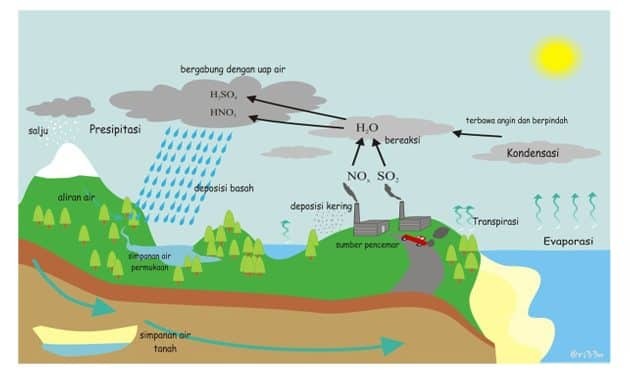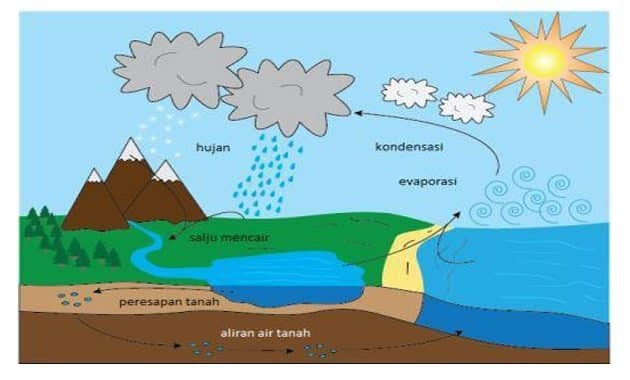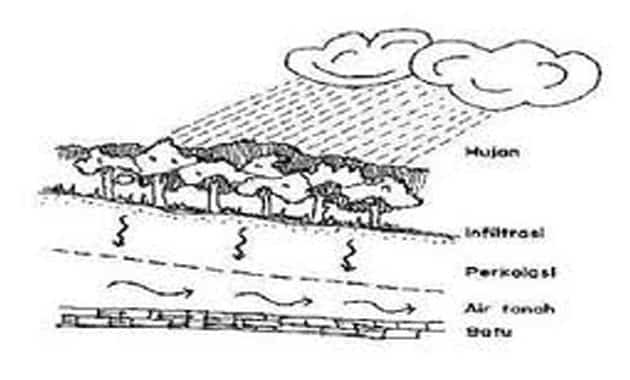Water Cycle: Definition, 7 Stages, Process, Illustrations Gambar
Education. Co. ID – On occasion this we will discuss about Water Cycle, which explanation this time will be equipped with 7 stages of the water cycle, understanding, processes and illustrations of the water cycle, for more details, please read the explanation below:

Understanding the Water Cycle
The water cycle is also known as the hydrological cycle, which means the circulation of water from the atmosphere to the earth and then back to the atmosphere. In this cycle, there are many stages that must be passed such as condensation, precipitation then evaporation and transpiration. As it is known that the earth is a planet whose surface consists of water and land. From a distance, it will be seen that the waters are much wider than the land. Sources of water on earth itself is very diverse, ranging from rivers, lakes, oceans, springs and so forth. So it is not surprising that many people are curious about the hydrological cycle.
Water cycle process
The water cycle is one of the biogeochemical cycles that occur on this earth. The water cycle is a cycle of water movement through three phases (gas, liquid and solid) in four (4) layers of the earth, namely the atmosphere, lithosphere, hydrosphere and biosphere.
The water cycle has many benefits, namely to regulate environmental temperatures, regulate weather changes, to create rain, and also to create a balance in the biosphere on earth.
Water Cycle Stages
Below is the water cycle through 7 processes that run systematically and regularly. The seven processes include:
Evaporation

This water cycle starts from the evaporation stage, Evaporation is a process of evaporation of water on the earth's surface caused by the heat energy from the sun. Liquid water and from various types of water sources (such as seas, lakes, rivers, land, etc.) it turns into water vapor and then rises up to the atmosphere. The greater the heat energy from the sun that reaches the earth's surface, the rate of evaporation will also be greater.
Transpiration

Evaporation in the water cycle at the earth's surface can also occur in plant tissues. This kind of evaporation is known as transpiration. Plant roots absorb water and then push it to the leaves to be used in a process called photosynthesis. The water from photosynthesis is then released by plants through the stomata as water vapor.
Sublimation

Apart from the above evaporation, sublimation also contributes to the formation of water vapor in the air. Sublimation itself is a process in which ice turns into water vapor without having to be in the liquid phase first. The main sources of water from this sublimation process are ice sheets from the north pole, south pole, and ice from the mountains. In the water cycle, sublimation is a slower process than evaporation.
Condensation

When water evaporates and becomes water vapor, it will rise to the upper layers of the atmosphere. At a certain height, the water vapor will turn into very small ice particles due to the influence of low air temperatures. This process is known as condensation. The ice particles will approach each other and unite after that to form clouds and fog in the sky.
Precipitation (precipitation)
The cloud (condensed water vapor) then descends to the earth's surface as rain caused by the influence of hot winds or due to changes in temperature. When the temperature is very low (below 0 degrees), water droplets fall as snow or hail. By going through one of the processes in this water cycle, the water will then enter back into the lithosphere layer.
runoff
Runoff is a process in which water flows over the earth's surface. The water moves and moves towards a lower place by going through water channels such as rivers and sewers until after that it enters lakes, seas, and oceans. At this stage of the water cycle, the water will re-enter the hydrosphere layer.
Infiltration

After the rain, not all of the water will go through the runoff stage. Some of them will move deep into the ground. This water is also known as infiltration water. Water seeps down and will become groundwater.
A few descriptions about the Water Cycle: Understanding, 7 Stages, Processes, and Illustrations, hopefully it can be useful for you.
See AlsoDefinition of Deficit, Causes, Impacts and How to Overcome It
See AlsoUnderstanding LAN, Components, Functions, Characteristics, Strengths & Weaknesses
See AlsoDefinition of Sedimentation
